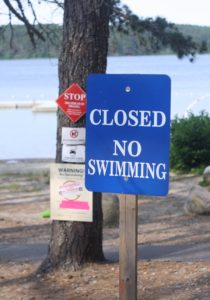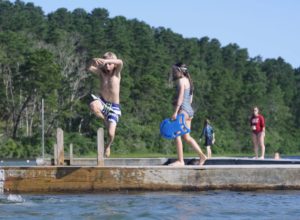WELLFLEET — On the afternoon of July 11 the beach at Gull Pond was empty: no chairs in the sand, no children doing cannonballs and belly flops from the dock. “CLOSED, NO SWIMMING,” a sign read. “Swimming May Cause Illness.”

A routine test the day before had found a high level of potentially toxic cyanobacteria in the deep water of the pond, and public health officials closed it as a precaution. It was the first time, as far as officials could remember, that a Wellfleet pond had been closed for that reason. It reopened for swimmers on July 16 after further testing.
But the outlook for the future health of the Outer Cape’s glacial kettle ponds is clouded. New research indicates that rapidly rising water temperatures and excess nutrient loading threaten to normalize cyanobacteria blooms. Exposure to the toxins such blooms produce can be dangerous. EPA studies have linked such exposure with amyotrophic lateral sclerosis (ALS).
Cyanobacteria, sometimes called “blue-green algae,” evolved 3.5 billion years ago, when the Earth was much warmer than today. “It’s a natural part of the pond community,” National Park Service aquatic ecologist Sophia Fox explained at a presentation on pond health on July 18 sponsored by the Wellfleet Nonresident Taxpayers Association.
“But under the right conditions,” she continued, “with higher temperatures and increased nutrient loading, these algae multiply very quickly and form what we call blooms, which is when they are so numerous that they become visible and begin producing toxins that are harmful to people, pets, and other organisms.”
Fox studies kettle ponds at the National Park Service’s North Atlantic Coastal Laboratory in North Truro. “Our data series on atmospheric deposition, water quality, and temperature are some of longest in the country,” she said. “The Outer Cape is one of the few places where we can actually scientifically analyze changes in rainfall and pond water temperatures and chemistry.”
An acid rain legacy

The “No Swimming” signs at Gull Pond last month were reminiscent of other signs at the ponds warning that their fish were contaminated with mercury. Those signs were recently taken down, apparently by mistake, because there has been no change in the amount of mercury found in pond fish. Wellfleet Health Agent Hillary Greenberg-Lemos said that the state is sending her new signs to repost.
Researchers first started collecting data from Cape Cod ponds in the 1980s to gauge the effects of acid rain. Pollutants from fossil-fuel-burning power plants in the Midwest were being carried hundreds of miles by rain, snow, sleet, and air currents and falling here, acidifying ponds and contaminating sediment with lead, PCBs, and mercury.
In 1990 Title IV of the Clean Air Act mandated controls on acid deposition, and Obama-era regulations like the Mercury and Air Toxics Standards and the Clean Power Plan further tightened emissions regulations.
“Because of [these regulations] we’ve seen a 30-fold decrease in acidity since the 1980s,” Fox said. “There’s a direct connection between what’s going on in the atmosphere and what’s happening in Wellfleet ponds. They’re incredibly responsive, like little puddles on the pavement.”
As humans continue to burn fossil fuels, air and water temperatures are increasing dramatically. “The surface temperature of Earth is increasing, and the area where we live is increasing at a rate higher than average,” said Fox. “Nights in the late summer and fall are not as cold as they used to be. Air temperatures [at night] have increased between three and seven degrees Fahrenheit over the last 30 to 40 years, and we’ve seen the exact same pattern in our pond waters.”
Because of these higher nighttime temperatures, ponds are more stratified — separated into lighter, warmer waters on top and denser, cooler waters beneath, without mixing — for a longer season.
The interplay between temperature and pH (acidity) regulates a huge variety of physical, chemical, and biological processes. Bottom waters become anoxic because they’re not mixing with the oxygenated surface. As a result, oxygen-loving organisms can no longer live there. Long-term stratification also causes the release of phosphorus from bottom sediments. Warm water and abundant phosphorus are the key ingredients for cyanobacteria blooms. It’s a classic feedback loop.
The phosphorus invasion
Increasingly, phosphorus is invading freshwater ecosystems from the land, too. Andrew Gottlieb, executive director of the Association to Preserve Cape Cod (APCC), also spoke at the July 18 forum on Wellfleet’s waters.
“The primary pathways [for phosphorus] into our ponds are atmospheric deposition as a byproduct of fossil-fuel burning, human waste disposal practices, and fertilizers,” he said. The APCC is currently monitoring 45 of Cape Cod’s roughly 1,000 ponds for cyanobacteria and has identified repeat blooms in 16 ponds in other areas of the Cape. “Nutrients drive a healthy, balanced ecosystem,” explained Gottlieb, “and what we have done is put that balance out of whack.”
Bryan Horsley, an APCC restoration technician, said by email that seven ponds in Barnstable, four in Brewster, two in Orleans, and one each in Dennis, Harwich, and Mashpee had seen at least two blooms in the last three years.
“There are certainly many other ponds that have had blooms occur just once during this time period,” Horsley wrote, “and others that have had more issues in the past and been treated with Alum, thus their issues are temporarily held off until the treatment wears off.”
Cliff Pond in Brewster has had repeated cyanobacteria blooms, including one in 1998 when four dogs were poisoned by drinking its water. The pond was closed for 99 days in 2012 and for 15 days in 2013, according to the Cape Codder.
Aside from responding to the bloom at Gull Pond in July and noting a bloom at Little Depot Pond in Eastham last year, the APCC is not monitoring any of the Outer Cape’s kettle ponds.
“I know other towns are having issues, but we haven’t had the resources to expand our monitoring to these areas yet,” Horsley wrote. “We are actively working to raise funds to hire additional seasonal interns to help expand capacity for this and future seasons.”
A water resource crossroads
The APCC’s Gottlieb suggested that proactive wastewater management and planning and significantly reducing the use of fertilizers could have a measurable impact on the Outer Cape’s water quality and the frequency of cyanobacteria blooms.
“We’re at a crossroads as a set of communities about what we want our water resources to look like,” he said. He named the conversion of summer homes to year-round use as one factor. From a wastewater management perspective, year-round nutrient loads from these homes’ septic systems present huge regulatory challenges. Septic systems are designed to manage bacteria, not nutrients.
“I didn’t need a permit to come live in my home year-round,” said Gottlieb, who lives in Mashpee, where he is a selectman. “But it has a significant impact,” as does the growth of short-term rentals and packing big groups of vacationers into single-family homes.
Then there’s landscaping. Over the past 50 years not just big farms but also home owners have come to rely on synthetic fertilizers to keep plants growing where they wouldn’t naturally.
“We have very sandy, very permeable soil,” said Gottlieb. “Most native plants on the Cape have adapted to our lousy soil and don’t need fertilizers. But if you want a putting green you have to fertilize it. Then we get a three-, four-, or five-inch rainstorm and in a matter of hours all that washes into the ponds. It makes things grow, just not the things you want to grow.”
And the nutrient problem is also related to fossil fuels: most synthetic fertilizers are made using byproducts of the petroleum industry.
It’s hard to absorb the enormity of what fossil fuels are costing us piecemeal, crisis by crisis. But like the mercury crisis of the 1950s and 1960s, the lead crisis of the 1970s, and the acid rain crisis of the 1980s, cyanobacteria blooms are inextricably linked to our dependence on these ancient molecules. We’re messing with biogeochemical cycles of the most common atoms required for life — carbon, nitrogen, and phosphorus — and the consequences mirror the scope.
The cyanotoxins produced by cyanobacteria are diverse. “They can cause a range of ailments from minor skin or respiratory irritation all the way up to severe issues like liver damage and neurological issues,” said Horsely. “There are links between airborne cyanotoxins and occurrences of ALS and Alzheimer’s disease.” Dogs and kids, he said, are especially vulnerable because they tend to drink more water from ponds and have smaller body mass.
In Wellfleet Gottlieb talked about “shifting baselines.” Coined by ecologist Daniel Pauly, the phrase refers to the way we measure systems against previous reference points, which themselves may represent significant changes from an earlier state.
“When I tell my kids about my childhood in Mashpee, they have no idea what I’m talking about,” said Gottlieb. “My friend’s father, who grew up in the early 1900s — his baseline no longer exists. It no longer existed when I established mine, and mine no longer existed when my children formed theirs. This matters because it’s hard to fight for what you never saw, what you never understood to be present.”



